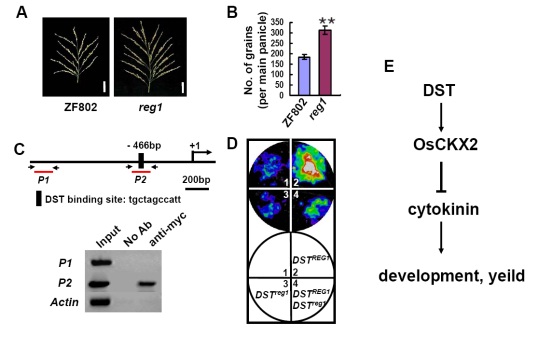Cytokinin positively regulates the activity and function of the shoot apical meristem (SAM), which is a major parameter determining seed production and finally influencing rice yield formation. The rice Gn1a/OsCKX2 (Grain number 1a/Cytokinin oxidase 2) gene, which encodes a cytokinin oxidase, is a major QTL (quantitative trait locus) contributing to grain number improvement in rice breeding practice. However, the molecular mechanism of how the expression of OsCKX2 is regulated in planta remains elusive.
To gain insight into the molecular mechanisms underlying the transcriptional expression of Gn1a, scientists in Dr. Chuanyou Li’s group from the Institute of Genetics and Developmental Biology, the Chinese Academy of Sciences carried out an extensive screening and identified a novel rice mutant, regulator of Gn1a 1 (reg1), which shows reduced OsCKX2 expression, elevated meristem activity, and increased grain number.
Map-based cloning studies revealed that the reg1 phenotype was caused by a semidominant mutation of the DST (DROUGHT AND SALT TOLERANCE) gene, which encodes a zinc finger protein that regulates drought and salt tolerance in rice. DST directly binds the promoter region of Gn1a/OsCKX2 and promotes its expression in vivo. In the reg1 mutant, the DSTreg1 still binds the promoter of OsCKX2, but losses the ability to activate the expression of OsCKX2; reduced expression of OsCKX2 leads to increased cytokinin accumulation in the SAM, which renders enhanced seed production of reg1.
Introduction of DSTreg1 to the high yield rice variety R498 with Gn1a mutant does not influence the yield formation, while a near isogenic line (NIL) containing the DSTreg1 allele in the genetic background of 93-11, a high yield rice variety without Gn1a mutant, shows increased yield in the plot test. Transgenic wheat lines with increased expression of DSTreg1 showed increased ear size and spikelet number.
Taken together, the dominant allele of DST provides a strategy for QTL pyramiding to combine the Gn1a-dependent and Gn1a-independent effect on grain number enhancement in rice. And DSTreg1 may be explored to facilitate the genetic enhancement of grain production in rice and other small grain cereals.
This work with Dr. Shuyu Li as the first coauthor has been online published on PNAS (http://www.pnas.org/content/110/8/3167). This research was supported by grants from National Natural Science Foundation of China.
AUTHOR CONTACT:
Chuanyou Li, Ph.D.
Institute of Genetics and Developmetnal Biology, Chinese Academy of Sciences, Beijing, China.
E-mail: cyli@genetics.ac.cn
(Image by Shuyu Li et al.)
Figure. DST controls the yield formation by promoting the expression of OsCKX2. (A) The panicle morphologies of ZF802 and reg1. Scale bar, 5 cm. (B) Comparison of grain number per main panicle between ZF802 and reg1. Values are means with SD (n = 30 plants). The double asterisks represent significant difference determined by the Student’s t-test at P < 0.01. (C) ChIP assay shows the association of DSTREG1 with the promoter of OsCKX2. Region between the two coupled arrow heads indicates the DNA fragment used for ChIP-PCR. Immunoprecipitation was performed with or without myc antibody (no Ab). (D) DSTREG1 promotes OsCKX2 expression in vivo. Tobacco leaves were transformed with pOsCKX2:LUC plus vector control (1), pUBI:DSTREG1 (2), pUBI:DSTreg1 (3) or pUBI:DSTREG1 and pUBI:DSTreg1 (4). (E) A proposed model for the role of DST in regulation yield formation.
 (Image by Shuyu Li et al.)Figure. DST controls the yield formation by promoting the expression of OsCKX2. (A) The panicle morphologies of ZF802 and reg1. Scale bar, 5 cm. (B) Comparison of grain number per main panicle between ZF802 and reg1. Values are means with SD (n = 30 plants). The double asterisks represent significant difference determined by the Student’s t-test at P < 0.01. (C) ChIP assay shows the association of DSTREG1 with the promoter of OsCKX2. Region between the two coupled arrow heads indicates the DNA fragment used for ChIP-PCR. Immunoprecipitation was performed with or without myc antibody (no Ab). (D) DSTREG1 promotes OsCKX2 expression in vivo. Tobacco leaves were transformed with pOsCKX2:LUC plus vector control (1), pUBI:DSTREG1 (2), pUBI:DSTreg1 (3) or pUBI:DSTREG1 and pUBI:DSTreg1 (4). (E) A proposed model for the role of DST in regulation yield formation.
(Image by Shuyu Li et al.)Figure. DST controls the yield formation by promoting the expression of OsCKX2. (A) The panicle morphologies of ZF802 and reg1. Scale bar, 5 cm. (B) Comparison of grain number per main panicle between ZF802 and reg1. Values are means with SD (n = 30 plants). The double asterisks represent significant difference determined by the Student’s t-test at P < 0.01. (C) ChIP assay shows the association of DSTREG1 with the promoter of OsCKX2. Region between the two coupled arrow heads indicates the DNA fragment used for ChIP-PCR. Immunoprecipitation was performed with or without myc antibody (no Ab). (D) DSTREG1 promotes OsCKX2 expression in vivo. Tobacco leaves were transformed with pOsCKX2:LUC plus vector control (1), pUBI:DSTREG1 (2), pUBI:DSTreg1 (3) or pUBI:DSTREG1 and pUBI:DSTreg1 (4). (E) A proposed model for the role of DST in regulation yield formation. CAS
CAS
 中文
中文




.png)
